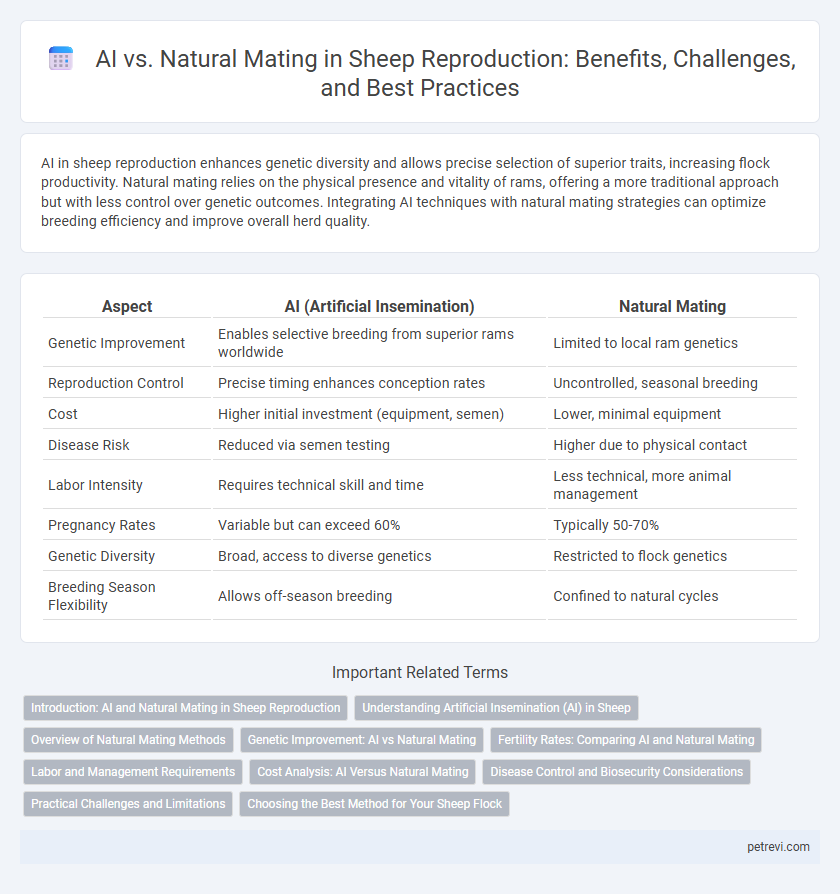AI in sheep reproduction enhances genetic diversity and allows precise selection of superior traits, increasing flock productivity. Natural mating relies on the physical presence and vitality of rams, offering a more traditional approach but with less control over genetic outcomes. Integrating AI techniques with natural mating strategies can optimize breeding efficiency and improve overall herd quality.
Table of Comparison
| Aspect | AI (Artificial Insemination) | Natural Mating |
|---|---|---|
| Genetic Improvement | Enables selective breeding from superior rams worldwide | Limited to local ram genetics |
| Reproduction Control | Precise timing enhances conception rates | Uncontrolled, seasonal breeding |
| Cost | Higher initial investment (equipment, semen) | Lower, minimal equipment |
| Disease Risk | Reduced via semen testing | Higher due to physical contact |
| Labor Intensity | Requires technical skill and time | Less technical, more animal management |
| Pregnancy Rates | Variable but can exceed 60% | Typically 50-70% |
| Genetic Diversity | Broad, access to diverse genetics | Restricted to flock genetics |
| Breeding Season Flexibility | Allows off-season breeding | Confined to natural cycles |
Introduction: AI and Natural Mating in Sheep Reproduction
Artificial insemination (AI) and natural mating represent two primary methods for sheep reproduction, each with distinct advantages in genetic improvement and flock management. AI allows precise selection of superior rams, enhancing genetic diversity and accelerating trait improvement, while natural mating relies on direct ram-to-ewe interaction, often resulting in higher conception rates in small or extensively managed flocks. Integrating AI with natural mating strategies can optimize reproductive efficiency and genetic gains in sheep breeding programs.
Understanding Artificial Insemination (AI) in Sheep
Artificial insemination (AI) in sheep involves collecting semen from a selected ram and implanting it into ewes to improve genetic traits and control breeding schedules. This technique allows for precise selection of superior genetic material, increasing flock productivity and disease control compared to natural mating. By optimizing reproductive efficiency, AI minimizes the need for maintaining multiple rams on-site, reducing costs and improving herd management.
Overview of Natural Mating Methods
Natural mating methods in sheep reproduction involve selecting rams for their genetic traits and allowing direct physical breeding within flocks, promoting natural selection and behavioral interactions. This approach supports genetic diversity and can be less costly compared to artificial insemination, relying on the ram's ability to detect estrus and successfully impregnate ewes. Proper management of ram-to-ewe ratios and breeding seasons is crucial to maximize conception rates and overall flock fertility.
Genetic Improvement: AI vs Natural Mating
Artificial insemination (AI) in sheep reproduction allows precise selection of superior genetic traits, accelerating genetic improvement by enabling controlled breeding with genetically elite rams across various locations. Natural mating relies on the genetic pool of rams present within a flock, resulting in slower rates of genetic progress and less uniform offspring quality. Implementing AI enhances the accuracy of desired trait propagation such as disease resistance, growth rate, and wool quality, optimizing flock genetics compared to traditional natural mating methods.
Fertility Rates: Comparing AI and Natural Mating
Artificial insemination (AI) in sheep reproduction offers controlled genetic selection, often resulting in higher fertility rates compared to natural mating, which can be influenced by ram compatibility and environmental factors. Studies indicate AI fertility rates range between 60-70%, while natural mating fertility rates typically vary from 50-65% depending on ewe health and ram fertility. Optimizing AI techniques, such as estrus synchronization and semen quality assessment, contributes significantly to improving conception rates in sheep flocks.
Labor and Management Requirements
AI in sheep reproduction demands precise timing, skilled labor, and specialized equipment to ensure successful breeding outcomes, which increases management complexity. Natural mating requires less labor input and minimal technical expertise, relying primarily on straightforward flock supervision and ram selection. Balancing AI's higher labor intensity against natural mating's simplicity is essential for optimizing flock productivity and resource allocation.
Cost Analysis: AI Versus Natural Mating
Artificial Insemination (AI) in sheep reproduction often incurs higher initial costs due to equipment, semen purchase, and specialized labor compared to natural mating, which primarily involves maintaining rams. However, AI can lead to long-term savings by enabling superior genetics selection, reducing the number of rams needed, and improving flock productivity and lambing rates. Natural mating offers lower upfront expenses but may result in less control over breeding outcomes and potential increases in disease transmission among sheep.
Disease Control and Biosecurity Considerations
AI in sheep reproduction significantly enhances disease control by minimizing physical contact and reducing the transmission of pathogens compared to natural mating. Strict biosecurity protocols during artificial insemination, such as sanitizing semen collection equipment and using tested, pathogen-free semen, further lower infection risks. Natural mating increases exposure to sexually transmitted infections and parasites, presenting challenges for maintaining herd health and biosecurity standards.
Practical Challenges and Limitations
AI in sheep reproduction faces practical challenges such as the need for precise estrus detection and skilled technicians to perform insemination, often resulting in lower conception rates compared to natural mating. Natural mating benefits from the ram's innate ability to detect ewe readiness and adapt to natural behavioral cues, reducing human intervention and logistical constraints. However, natural mating poses risks like disease transmission and uncontrolled genetics, limiting selective breeding efforts that AI can better support despite its operational complexities.
Choosing the Best Method for Your Sheep Flock
AI in sheep reproduction offers precise genetic selection, reducing disease transmission and increasing lambing rates compared to natural mating. However, natural mating provides behavior-driven breeding that enhances flock adaptation and is less resource-intensive. Evaluating factors such as flock size, breeding goals, and available technology helps determine the optimal method for maximizing sheep production efficiency.
AI vs Natural Mating for Sheep Reproduction Infographic

 petrevi.com
petrevi.com